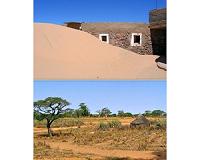 |
Kingston RI (SPX) Jan 04, 2011 Erosion is a significant problem on highway embankments in New England. To mitigate erosion on the regions' highways, slopes are seeded with a grass-legume mixture that usually including red fescue, a grass preferred for its drought-tolerance and ability to thrive in acidic, infertile soil. "A mixture of red fescue, perennial ryegrass, and kentucky bluegrass is planted to stabilize the soil, but only the red fescue survives long term on slopes", noted Rebecca Nelson Brown, lead author of a report in HortScience. Brown and a team from the Department of Plant Sciences at the University of Rhode Island designed a study to identify alternative grass species that could help anchor slopes and prevent costly erosion. Twenty-two grass species were included in the study conducted in the greenhouse at the Skogley Turf Research Center of the University of Rhode Island, and in additional roadside trials on the shoulder of a nearby state highway. Since federal highway policy strongly encourages the use of native vegetation in highway right-of-ways, the researchers tested grasses native to southern New England, comparing rooting depth, plant height, and adaptation to roadside conditions. Sixteen native grasses and five amenity grasses with red fescue were tested. Roadside embankments are generally constructed of subsoil and gravel, over which 2 to 6 inches of topsoil is spread. The subsoils are very stony with coarse-textured loamy sand between the rocks; topsoil ranges from medium textured silt to sand. Red fescue is shallow-rooted with most of the root mass confined to the topsoil layer. When root growth is concentrated in a shallow mat with a sharp boundary in the soil profile, slope failure is likely to occur beneath the mat. Identifying alternative grasses that feature more even distribution of root mass with depth could help provide better slope stabilization. Combined results of the greenhouse and roadside trials showed little bluestem, purple lovegrass, and tall fescue to be the best choices for anchoring roadside slopes. "All species root deeply and are adapted to roadside conditions but are similar in stature to red fescue", stated Brown. The researchers found that big bluestem, indiangrass, switchgrass, and bitter panic grass also combine deep rooting with adaptation to roadside conditions, but were significantly taller than red fescue. "These grasses are likely to be too tall for use on mowed roadsides. However, to the extent that populations of these species differ in height, selection for deep rooting coupled with reduced topgrowth would be effective in developing cultivars better suited to roadside use", noted the report. The authors observed that little bluestem and purple lovegrass are warm-season grasses and dormant from October through May, adding that the best way to use these grasses would be as a mix with red fescue and other shallow-rooted cool-season grasses with rapid vegetative spread and minimal winter dormancy. The deep-rooted species would anchor the slope, whereas the rapidly spreading species prevented surface erosion, slowed runoff, and provided the green roadsides desired by the public. According to the study, an added benefit to using a mix of species is cost-reduction, because seed of little bluestem and purple lovegrass is substantially more expensive than seed of red fescue and other traditional turfgrasses and a mix would permit the little bluestem and purple lovegrass to be seeded at reduced rates. "This work should be useful as a guide in choosing grass species to stabilize slopes", the researchers concluded.
Share This Article With Planet Earth
Related Links American Society for Horticultural Science Dirt, rocks and all the stuff we stand on firmly
 How Earth's Orbital Shift Shaped The Sahara
How Earth's Orbital Shift Shaped The SaharaMoffett Field CA (SPX) Dec 22, 2010 The Sahara, the world's largest desert, was once fertile grassland. This fact has been common knowledge in the scientific community for some time, but scientists are still grappling with historic data to determine whether that transition took place abruptly or gradually. At the European Geosciences Union General Assembly held in Vienna, Austria earlier this year, researchers presented new ... read more |
|
| The content herein, unless otherwise known to be public domain, are Copyright 1995-2010 - SpaceDaily. AFP and UPI Wire Stories are copyright Agence France-Presse and United Press International. ESA Portal Reports are copyright European Space Agency. All NASA sourced material is public domain. Additional copyrights may apply in whole or part to other bona fide parties. Advertising does not imply endorsement,agreement or approval of any opinions, statements or information provided by SpaceDaily on any Web page published or hosted by SpaceDaily. Privacy Statement |